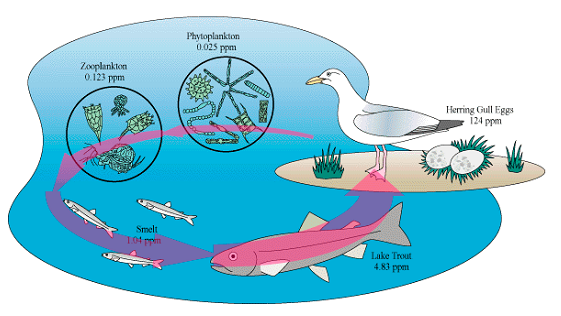Ecology
Of Fish and Ocean Things
MINDS ON
Check your backyard!
Giant hogweed is endemic to parts of Asia but has started threatening organisms in Southern Ontario. It was originally introduced as a gardening variety but without natural insects to consume it, giant hogweed has become a painful reminder of what happens when plants travel.
Check your Great Lake!

Their jawless mouth acts like a suction cup to gorge itself on the flesh of a fish it latches onto.
by Unknown author used under ShareAlike CC BY-SA
The fish usually die from the wound as it can become infected. This species contributed to the devastation of the Great Lakes fishery industry by the mid-1950s. Within 50 years of its introduction fisheries were only catching 2% of their former haul. Next time you are swimming in the Great Lakes you can think of the lamprey! But don’t worry - they are not interested in humans and generally stay in the depths far beyond where you swim.
U4A2Quiz
 Invasive Species
Invasive Species
As a follow up, select an invasive species threatening or possibly threatening to Ontario; and
1) describe how it got to Ontario/Canada (or how people think it may have got here).
2) identify a potential risk or hazard.
ACTION
Chain Reactions
U4A2WorkingWithSimulation
Building Food Chains
U4A2FoodChain
U4A2ForestEcosystemGizmoFollowup
Mini Task
Energy is not the only item passed from one organism to the next when it is eaten. Harmful substances like some heavy metals (definition:metals like mercury, lead and copper that the human body is not able to process safely)as well as pesticides (definition:a chemical that kills insects, such as DDT) are transferred with the food.

Mercury is a heavy metal used in the small-scale production of gold. As the mercury-gold-impurity mixture is heated, the mercury becomes a toxic vapour leaving the gold behind. Mercury can build up in the human brain (causing mental instability) and placenta (definition:the organ responsible for providing nutrition to a growing baby) causing children to have lung, kidney and brain damage as well as hearing and vision challenges). Consequently, it is important for all people to protect themselves from exposure. Unfortunately, mercury still makes its way into rivers, lakes and oceans from a variety of industrial processes.
Use the data in the chart below to construct a bar graph that shows each organism and its comparative level of mercury. We use the units parts per million (PPM) to describe the concentration of chemicals. A higher PPM indicates a higher concentration.
|
Organism |
Mercury Level (ppm) |
|---|---|
|
Crawfish |
0.033 |
|
Shark |
0.979 |
|
Tuna |
0.689 |
|
Bony fish |
0.235 |
 Graphing Checklist
Graphing Checklist
Complete your graph and give it a quick check according to the list. Does your graph:
-
have a labelled x-axis (along the bottom)?
-
have a labelled y-axis that includes ‘ppm’?
-
have consistent numbering along each axis?
-
each bar in your bar graph is the same width?
-
have a title?
-
have clear visuals (no 3D effects)?
Bioaccumulation
If fish were able to get rid of mercury from their bodies, the mercury level in the fish should be the same as the water. Unfortunately, mercury and other toxins bioaccumulate (definition: a substance, such as a heavy metal, that increases in an organism over time, or build up, in fish and other organisms because these organisms lack a way to filter it out of their body.
This process gets worse when 10 contaminated fish are eaten by one top predator. That top predator now has all of the mercury contained in the 10 contaminated fish! This is called biomagnification.(definition:the concentrating of a substance in a body caused by the consumption of contaminated food) The ‘higher up’ in the food chain an animal is, the more contaminants are present in its body. Since humans are at the top of many food chains, we need to be aware of this and make food choices accordingly. For instance, many doctors recommend that women limit their intake of tuna during pregnancy to prevent mercury from collecting in the baby’s placenta.
U4A2Bioaccumulation
 Tip - Save Your Work
Tip - Save Your Work
- Save both your graph and the food chain for later.
- When saving documents ensure you have named the file with a meaningful title so you can refer back to it easily.
 Mercury in the Environment
Mercury in the Environment
Mercury is also a problem here in Canada. Read the article or listen to the segment from CBC radio.
Unless you are the first contributor to this discussion, select a stakeholder (definition:someone who has a personal interest in the outcome of a difficult situation) that is currently not represented in the class discussion.
- What is the personal health risk to individuals?
- What is their role in causing the disaster?
- How do you determine their level of responsibility in the cleanup?
- What can be done in this situation?
You are encouraged to read and discuss updates to this situation.
Possible Stakeholders:
- Aboriginal community members
- Pulp and Paper Mill workers
- Federal government
- Community leaders
- Provincial government
- Grocery store clerk
U4A2MemoryGame
CONSOLIDATION
U4A2ComparingAquaticTerrestrialEcosystems
 Your Turn
Your Turn
Using the list of animals provided construct a single food web. Check your work by ensuring that your answer contains a mini aquatic food web connected to a mini terrestrial food web. You can create your food web with your favourite desktop publishing, photo or paint app or software and save the electronic file. You may also choose to draw it by hand, take a photo of your work and upload it.
List: Insects, red-winged blackbird, hawk, mouse, deer, rabbit, plankton, fish, duck, snakes, fox, owl, small fish, crawfish.
